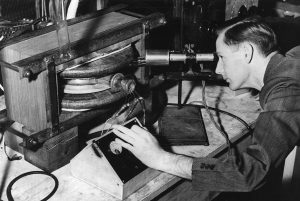Professor Donald Kerst built the world’s first magnetic induction accelerator in 1940. The betatron weighed in at just under four tons and required about 30 kilowatts to run. Branded as the “World’s Most Powerful X-Ray Machine,” the betatron could accelerate electrons at speeds of more than 158,000 miles per second and give them an energy of more than 2.5 million electron volts. At the time, this was the highest velocity ever produced by any machine. The images produced by the betatron were described by Arthur Wildhagen of Scientific American as “knife-sharp” (1943). The betatron operates by giving the electrons inside the vacuum tube a continuous “push” using a magnetic field, which allows them to attain their great speed and energy.

The original Betatron was called many different names, ranging from “rheotron” and “inductron” to “Super X-ray Machine” and “cosmic ray machine.” Eventually, Professor Kerst held a departmental competition. After receiving many entries, one of the most interesting being: “Ausserordentlichhochgeschwindigkeitelektronenentwickelndenschwerarbeitsbeigollitron,” which roughly translates as “Hard working by golly machine for generating extroadinarily high-velocity electrons.” Kerst eventually decided on “betatron.”

From the beginning, Professor Kerst identified three major applications for later incarnations of the betatron: 1) For industry, a powerful source of X-rays of 20 to 30 million volts energy; 2) For medicine, a source of x-rays or for an electron beam for use against cancer and other malignant tissues; and 3) For scientific research, a powerful X-ray and electron source with precision control, and a laboratory source of cosmic rays, produced at energies of 250 million volts or more.
As with many devices of the day, the later incarnations of the Betatron captured the military’s interest. A portable version of the betatron, or a “baby” Betatron, was developed in secret during World War II. Developed by Professor Gerald M. Almy, while Professor Kerst was away working on the atomic bomb, this Betatron could generate radiation equal to that of 3 grams of radium at one-tenth of the price.
The betatron had a lasting impact on the design of other atom smashers. Power giant General Electric later built a 100 million volt betatron for personal use, but researchers at the time believed it had little practical application beyond the field of physics.
– Loomis Laboratory. 25 MeV Betatron located in the northwest corner near the study tables.
Learn more about Kerst and the Betatron in this blog post from the University Archives
Department of Physics. (2013). Physics in the 1940s: The Betatron. Retrieved on February 11th, 2013 from http://physics.illinois.edu/history/Betatron.asp.
Donald Kerst and the Betatron. 1946. Photograph Subject File, 1868-, Record Series 39/2/20, Box 120, Folder ENG 10-3 Phyiscs Laboratories. University of Illinois Archives.
Kingery, R. A., Berg, R. D., & Schillinger, E. H. (1967). Men and Ideas in Engineering. University of Illinois Press: Urbana.
Kerst, D. W. “Development of the Betatron and Its Place in Science”. From Talk Given at Dedication of Betatron, United States Army Arsenal, Picatinny, New Jersey, Record Series 11/10/12, Box 14, University of Illinois Archives.
Wildhagen, A.R. (May, 1943). “The Betatron”. Scientific American, Record Series 11/10/12, Box 4, University of Illinois Archives.
World’s First Betatron. (October 1966). Photograph Subject File, 1868-, Record Series 39/2/22, Box 120, Folder ENG 10-2 Physics Faculty. University of Illinois Archives.
Wright, J. (Sun, Apr. 14, 1943). Baby Betatron. University of Illinois News.
